| We were all packed and ready to head south to Sparti (Sparta) and our new base for the next leg of our adventures when in a moment, our plan went completely out the window. Deciding to take advantage of the reasonable English our hotel proprietor spoke, we showed her our pyramid book, hoping to get a more accurate location for our next target pyramid. We knew it was on a peak, somewhere around mount Taygetus and were quite prepared to check every one if needs be. She translated the caption to the one available photo which is used by all but according to this, the most authoritative source we've come across, it was only made of snow. Decidedly crestfallen, we sought a second opinion and headed for the archaeological museum where the curator confirmed that this indeed, was just a freak of nature and not a pyramid by any stretch of the imagination. |
| In need of a new plan, we elected to concentrate on the remains of the Mycenaean culture and compare their stonework with that of the pyramids of Hellenicon and Ligourio. These people invaded Greece from Turkey and dominated from 2100 BC until the death of King Agamemnon of Trojan War fame, in about 1200 BC. The citadel of Mycenae, after which the culture is named was the most powerful of all, so seemed the best place to investigate. |
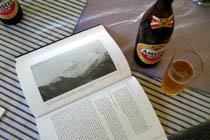 |
|
|
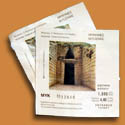 |
Once again, we were back at a site on the tour bus itinerary. It definitely takes the edge off things when amongst the Tower of Babel language profusion that fills the car park, you hear people comparing notes, “Yeah, did Olympia this morning, this place now and we'll do that Roman theatre at Epidaurus this afternoon.” |
|
| Two thousand years of human history and endeavour covered in a day, and they've the home video to prove it. |
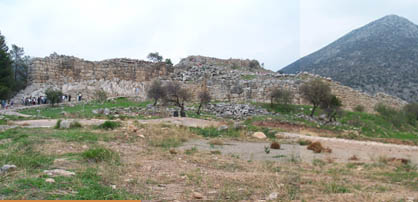 |
|
| Undeterred, we headed towards the Lion Gate, symbol of the mighty House of Atreus, treading in the footsteps of legendary heroes like Achilles and Odysseus. Trying to get an unobstructed photo though is like crossing a motorway. You wait for ages and just when you think it's clear, someone appears from nowhere and gets in your way. But we persevered and ferreted around everything the site had to offer, looking for any clues or inspiration. |
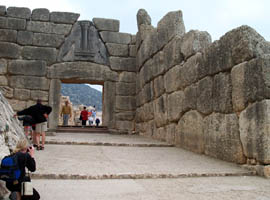 |
|
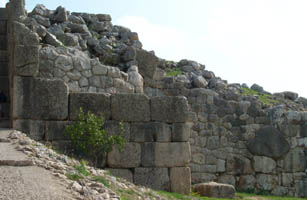 |
Thankfully, the initial climb had drained most of the sandal clad hoards and the back end of the site was almost our own. |
|
|
|
|
| After a few hours though we were none the wiser. Certainly it contained sections that were very similar but others seemed very poorly constructed by comparison. This site has been occupied since 6000 BC and who did what and when, is not made clear at all. Slabs of modern concrete didn't help us but did provide the panoramic views for the masses they were presumably intended for. |
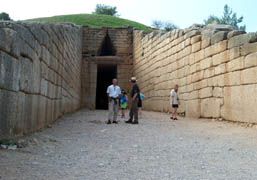 |
Pausing only to take in the immensely impressive tomb of Agamemnon halfway down the hill, we returned to Nafplio to reflect on our days experiences. |
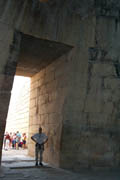 |
|
| With a day spare now, we decided to have another go at the pyramid at Nea Epidaurus, the one we'd failed to find a couple of days ago. Confident that with more time and better light , we'd be more successful on this occasion, we went back to the taverna where we'd originally sought some local knowledge. Our man wasn't there but most of the towns senior citizen Ouzo appreciation society were and after more than an hours discussion and the arrival of several more members, a likely area was generally agreed upon. Despite the fact that most of them had been hunting in this area all of their lives, they had never seen nor heard of this pyramid but eventually, a younger and more sober member of the gang volunteered to show us the way, so off we went. |
| It was near to where we'd first looked, the other side of the same hill and our escort wished us luck and headed back to civilisation. Enthusiastically, we scanned it for obvious signs but in their absence, picked a likely area and began scrambling up. |
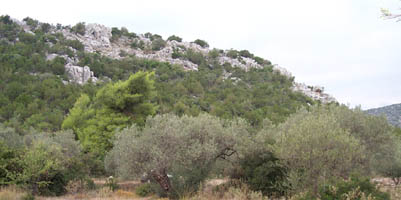 |
| But the terrain, covered everywhere in heavy, impenetrable scrub except where the protruding rock was vertical, was hard going. We eventually reached the outcrop we were aiming for but our efforts were to be unrewarded. It was just another trick of nature where the rocks had fallen together, the hand of gravity and not man. So for the next four hours we searched up and down, high and low and traversed across the entire hill face. But as the hours rolled by, the enormity of our task became more and more evident. We were looking for less than a dozen stones, at most 4 foot tall of which only two or three where of a sufficiently unnatural shape as to be discordant with the rock strewn natural terrain that stretched out for miles all around. Given that these may well have been overrun with vegetation, our initial optimism was eventually surpassed by a sense of utter futility. |
| Everything was starting to look the same because it pretty much was and by now, we were beginning to lose our bearings altogether. Despondent and by now pierced by enough thorns for a crucifixion, we accepted defeat and headed back down hill to the sanctuary of the expedition vehicle. |
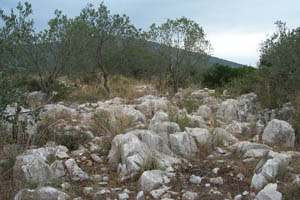 |
| We'd given it our best shot but the remains of the pyramid of Nea Epidaurus seemed determined to remain lost in the inhospitable and isolated terrain that have kept it secret for centuries.
|





